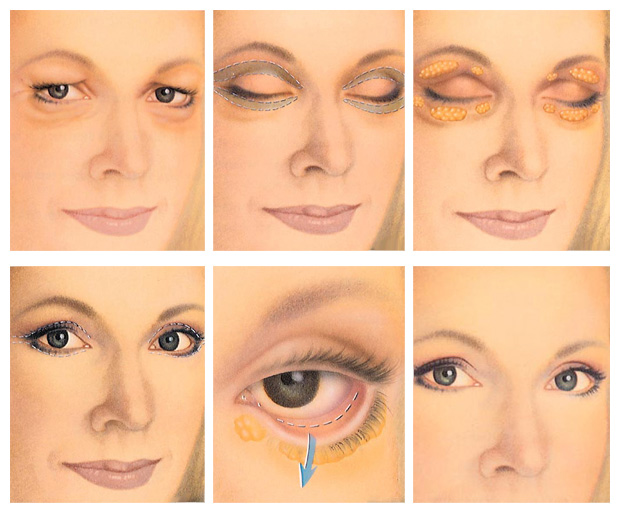Eyelid Surgery (Blepharoplasty) Jacksonville, Ponte Vedra, Fl
Eyelid Surgery Jacksonville, Ponte Vedra, Fl
Eyelid surgery, also called an eyelid lift or blepharoplasty, can rejuvenate puffy, sagging or tired-looking eyes by removing excess fat, skin and muscle from the upper and/or lower eyelids. Eyelid surgery may be performed for cosmetic reasons or to improve sight by lifting droopy eyelids out of the patient’s field of vision.
Eye lifts are ideal for the correction of loose, sagging and folded upper eyelids that may limit vision, puffy fat deposits in the upper eyelids, under-eye baggage, sagging lower eyelids and fine wrinkles in the lower eyelids.
Recovery time for eyelid surgery is usually between 2 and 4 weeks with most patients resuming activities within 3 – 5 days, and may return to work in about 10 days. Results aren’t immediate and may take 1 – 2 months to fully realize a more awake and cheerful look around the eyes, and greater self-confidence.
Am I a good candidate for eyelid surgery?
Any one or combination of the following conditions may indicate that you may be considered a good candidate for eyelid surgery:
- Excess skin obscuring the natural fold of the upper eyelids
- Loose skin hanging down from the upper eyelids, perhaps impairing vision
- A puffy appearance to the upper eyelids, making the eyes look tired
- Excess skin and fine, “crepe paper type” wrinkles of the lower eyelids
- Bags and dark circles under the eyes
- Lower eyelid droopiness
Aesthetic eyelid surgery can usually correct these problems, though other treatments may also need to be considered. Some examples follow. If the upper eyelid condition is accompanied by sagging of the eyebrows, then a forehead lift may be recommended. Smoothing of crow’s feet may be accomplished with Botox®, chemical peeling or laser resurfacing procedures. Circles beneath the eyes caused by dark pigmentation may be treated with fillers such as Hyaluronic Acid or fat as well as bleaching solution or chemical peel. Contact Dr. Duffy if you have an interest in any of these additional procedures.
Upper Eyelids
For upper eyelid surgery, generally an incision is hidden within the natural fold of the upper eyelid and extends slightly beyond the outside corner into the laugh lines or other existing creases. Through this incision, excess skin and fatty tissue are removed. Because the incision follows the natural contour of the upper eyelid, it usually is inconspicuous.
Lower Eyelids
For lower eyelid surgery, often an incision is hidden just below the lower lashes. Through this incision, excess skin, muscle and fat are removed, or fat may be redistributed to eliminate puffiness or bulges. Other adjustments to correct special problems such as muscle laxity may be performed. As in upper eyelid surgery, placement of the incision in natural crease lines allows for the scar to usually heal in an inconspicuous fashion. In some cases, you and your surgeon may decide that the best approach for removing excess fat is through an incision placed inside the lower eyelid. This technique requires no external incision, but it cannot be used to remove excess skin. A laser may sometimes be used in conjunction with this method to tighten the lower eyelid skin.
 Results of Your Eyelid Surgery
Results of Your Eyelid Surgery
Aesthetic eyelid surgery has the effect of making you look more rested, refreshed and alert. Since the healing process is gradual, you should expect to wait at least several weeks to get an accurate picture of the results of your eyelid surgery. Incisions will fade over a number of months usually becoming barely visible. The results of aesthetic eyelid surgery are usually long-lasting, but they may be affected by heredity and lifestyle factors. Removal of fat from your eyelids, which is usually the cause of puffiness and bags, is permanent, and these conditions generally will not recur. The skin continues to age, however, and skin laxity along with the fine wrinkling of the eyelid area may, at some point, return.
Sometimes loss of tone in the forehead causes additional sagging of the eyebrows which mimics a recurrence of drooping upper eyelids. If this happens, correction may require a forehead lift or a secondary eyelid procedure. Even though the aging process continues, patients are usually happy with their appearance for many years following eyelid surgery. Some patients find that they want to make additional improvements at a later time.
Eyelid Surgery (Blepharoplasty) Jacksonville Resource Links
Plasticsurgery.org
Medicine.net
Wikipedia



 Results of Your Eyelid Surgery
Results of Your Eyelid Surgery